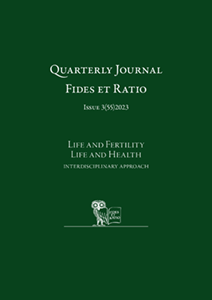Abstract
Fertility Awareness-based Methods (FAMs) observe physiological signs to determine fertile and infertile phases in a women's cycle. WHO recommends to use both natural family planning (NFP) or FAM as a synonym. They may serve as methods for family planning as well as a procreation health monitor in restorative medicine and as a useful biomarker in management of reproductive-health disorders. Unfortunately, this knowledge is marginalized during medical education. A cross-sectional study was performed among 542 Polish medical students to assess their skills in NFP. The most common NFP method indicated by 84.9% students was the Calendar Method, the one with historical value. The Billings Method and Creighton Model System were known by 42% and 14% participants respectively, while Multi Index Methods were known by 26.4%. A total of 6% of the respondents use NFP themselves. The largest group of students (42%) assessed the effectiveness of NFP in avoiding pregnancy at about 50%. The results show little interest and incomplete knowledge in up to date NFP among future medical professionals. It seems there is an urgent need to introduce this subject into medical education as a valuable tool to understand and monitor procreation health as well as family planning method.
References
Bączek, G. et al. (2017). Knowledge and opinions of medical Staff on Natural Fertility Awareness Methods, Kwartalnik Naukowy Fides et Ratio, 32, 215-232
Chawłowska, E., Lipiak, A., Krzysztoszek, J., Krupa, B. & Staszewski, R. (2020) Reproductive Health Literacy and Fertility Awareness Among Polish Female Students. Frontiers in Public Health, 8 (September), 1–12. https://doi.org/10.3389/fpubh.2020.00499
Choi, J. et al. (2010). Natural Family Planning: Physicians’ Knowledge, Attitudes, and Practice, Journal of Obstetrics and Gynaecology, 32, 673-678.
Danis, P, Kurz, S. & Covert, L. (2017). Medical Students’ Knowledge of Fertility Awareness-Based Methods of Family Planning, Frontiers in Medicine, 4, https://doi.org/10.3389/fmed.2017.00065
Dębska, S., Szyszka, M., Bączek, G. & Dmoch- Gajzlerska, E. (2017). The knowledge of physiology of female fertility and natural family planning methods among medical students. Nursing and Public Health, 7(2), 141–147. https://doi.org/10.17219/pzp/64687
Duane M, Stanford, J.B., Porucznik C.A., Vigil, P. (2022) Fertility Awareness-Based Methods for Women’s Health and Family Planning, Frontiers in Medicine, 9, https://doi.org/10.3389/fmed.2022.858977
Fehring, R.J. (2005). New low- and high-tech calendar methods of family planning. Journal of Midwifery and Women’s Health. https://doi.org/10.1016/j.jmwh.2004.07.001
Fehring, R.J. & Mu, Q. (2014). Cohort efficacy study of natural family planning among perimenopause age women. Journal of Obstetric, Gynecologic, and Neonatal Nursing, JOGNN / NAACOG, 43(3), 351–358.
Frank-Herrmann, P. et al. (2007). The effectiveness of a fertility awareness based method to avoid pregnancy in relation to a couple’s sexual behaviour during the fertile time: a prospective longitudinal study. Human Reproduction, 22(5), 1310–1319.
Hilgers, T.W., Stanford, J.B. (1998). Creighton Model NaProEducation Technology for avoiding pregnancy. Use effectiveness, The Journal of Reproductive Medicine, 43(6), 495-502 PMID: 9653695
Johnson S, Marriott L, Zinaman M (2018) Can apps and calendar methods predict ovulation with accuracy?, Current Medical Research and Opinion, 34(9), 1587-1594, https://doi.org/10.1080/03007995.2018.1475348
Manhart, M.D., Duane, M., Lind, A., Sinai, I. & Golden-Tevald, J. (2013). Fertility awareness-based methods of family planning: A review of effectiveness for avoiding pregnancy using SORT, Osteopathic Family Physician https://doi.org/10.1016/j.osfp.2012.09.002
Meston, C.M., Buss, D.M. (2007). Why Humans Have Sex. Arch Sex Behav 36, 477–507. https://doi.org/10.1007/s10508-007-9175-2
Muzyczka, K., Rząca M., Deluga, A., Denisow, M., Janiec, E., Krzos, A., Oleszczuk, K., Przystupa, H. (2012). Wiedza studentów Uniwersytetu Medycznego w Lublinie na temat płodności i metod planowania rodziny, (W:) J.K. Stępkowska, K.M. Stępkowska (red.), Instytucja rodziny wczoraj i dziś. Perspektywa interdyscyplinarna. Społeczeństwo i kultura. Tom 2, 51-58, Lublin: Wydawnictwo Politechnika Lubelska.
Natural family planning: A guide to provision of services. (1988). Geneva: World Health Organization.
Ohme-Peters, S. & Fedra work Group. (2019). Natural Family Planning Manual. Theoretical Basis for all NFP methods. European Institute for Family Life Education.
Pallone, S.R. & Bergus, G.R. (2009). Fertility Awareness-Based Methods: Another Option for Family Planning. The Journal of the American Board of Family Medicine, 22(2), 147-157. https://doi.org/10.3122/jabfm.2009.02.080038
Pedro, J., Brandão, T., Schmidt, L., Costa, M.E. & Martins, M.V. (2018). What do people know about fertility? A systematic review on fertility awareness and its associated factors. Upsala journal of medical sciences, 123(2), 71–81. https://doi.org/10.1080/03009734.2018.1480186
Prior, E., Lew, R., Hammarberg, K. & Johnson, L. (2019). Fertility facts, figures and future plans: an online survey of university students. Human Fertility, 22(4), 283–290. https://doi.org/10.1080/14647273.2018.1482569
Simmons, R.G. & Jennings, V (2020). Fertility awareness-based methods of family planning. Best Practice and Research: Clinical Obstetrics and Gynaecology, Bailliere Tindall Ltd. https://doi.org/10.1016/j.bpobgyn.2019.12.003
Ślizień-Kuczapska, E. (2007). Czy metody rozpoznawania płodności potrzebują nowych technologii? (W:) R. Domżał-Drzewiecka, E. Gałęziowska (red.) Nowoczesne metody rozpoznawania płodności wybrane zagadnienia, 109-120, Lublin: Wydawnictwo Makmed.
Smoley, B.A. & Robinson, C.M. (2012). Natural family planning. American Family Physician, 86 (10), 924–928.
Targan, M., Świetlik, D., Kicińska, A., Kardasz, K. & Wierzba, T. (2018). Wiedza studentów trójmiejskich uczelni wyższych na temat fizjologii prokreacji oraz metod rozpoznawania płodności. Kwartalnik Naukowy Fides et Ratio, 35(3), 55-69.
Unseld, M., Rötzer, E., 2, Weigl, R., Masel, E., Manhart, M. (2017). Use of Natural Family Planning (NFP) and its effect on couple relationships and sexual satisfaction: a Multi-country survey of NFP Users from US and Europe. Frontiers in Public Health, Vol. 5, Article 42.
Unseld, E., Schliep, K. & Stanford, J. (2012). Natural procreative technology for infertility and recurrent miscarriage: outcomes in a Canadian family practice. Canadian family physician. Medecin de famille canadien, 58(5), e267–e274.
Van der Wijden, C. & Manion, C. (2015). Lactational amenorrhoea method for family planning. The Cochrane database of systematic reviews, (10), CD001329. https://doi.org/10.1002/14651858.CD001329.pub2
Vigil, P., Blackwell, L.F. & Cortés, M.E. (2012). The Importance of Fertility Awareness in the Assessment of a Woman’s Health a Review. The Linacre Quarterly, 79(4), 426–450. https://doi.org/10.1179/002436312804827109

